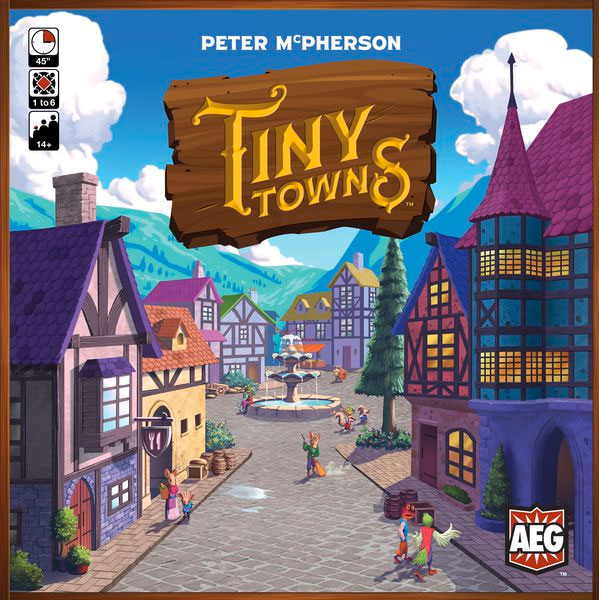AEG’s Tiny Towns is a tabletop game with a lot going for it. The objective is clean and clear; you are the mayor of a burgeoning town, and it’s up to you to design the architectural layout and create an environment that will keep your townspeople fed, fulfilled, and entertained. Setup is straightforward, all ages are welcome, and a session with three to five players can be completed in about an hour. If you’re looking for a game that won’t devour hours on end but still demands strategic thinking, Tiny Towns looks forward to your mayorship.
The game’s design is deceptively simple. Each player uses colored blocks that signify raw materials (wood, glass, brick, etc.) to build structures on a small, personal board that resembles a bingo card. To build, players need to follow specific shape and color schemes. As you go, you’ll have to think about the kinds of buildings you’ll need and the proper placement for each.

Your chief impediment is, well, the tininess of the board. Creating a number of cooperative structures on such a small landscape requires a lot of forethought. However, you will also need to adapt your plans as the game progresses, as other players may select building materials that are incompatible with your design.
Making the most of your real estate is the primary challenge, as you don’t want to end the game with scattered patches of earth that are too small for new buildings. These buildings include cottages—the town’s staple structure— as well as farms to feed your townspeople, factories that produce building materials, chapels, taverns, bakeries, and many more. Additionally, each player will be at work building their own secret “monument,” the successful completion of which yields a high point reward.
My group found that we didn’t have a great sense of the mechanics until our third round. There’s a lot of trial and error involved in the design process, and the desire to play again kicked in once we developed a better sense of the game’s expectations.
Tiny Towns’ game pieces are manufactured exceedingly well. There’s nothing breakable here, and, should a stray piece fall to the floor, everything is colorful and easy to find. A set of explanatory cards, placed in the center of the table, allow for easy reference whenever a player needs to reassess their strategy. (And you will need to regularly reassess your master plan.)

If you’re looking for a tabletop game that incorporates a narrative experience, you’ll want to look elsewhere. There is no story here; Tiny Towns is pure strategy. That said, the strategy is both easy to learn and surprisingly deep. As players increase their understanding of the mechanics with each subsequent session, they will be eager to return to the game and try out new designs. That built-in desire to sit down and play again earns Tiny Towns a high recommendation. I am already envisioning my next strategy.
Author: Palo Sionoplia

